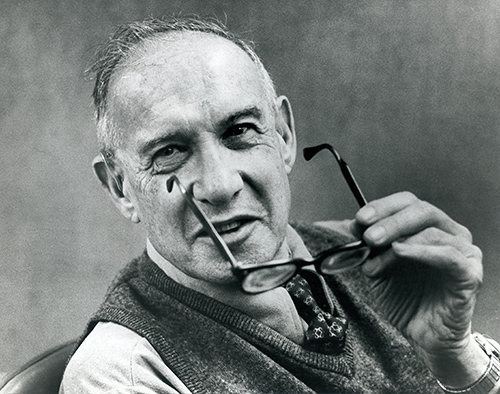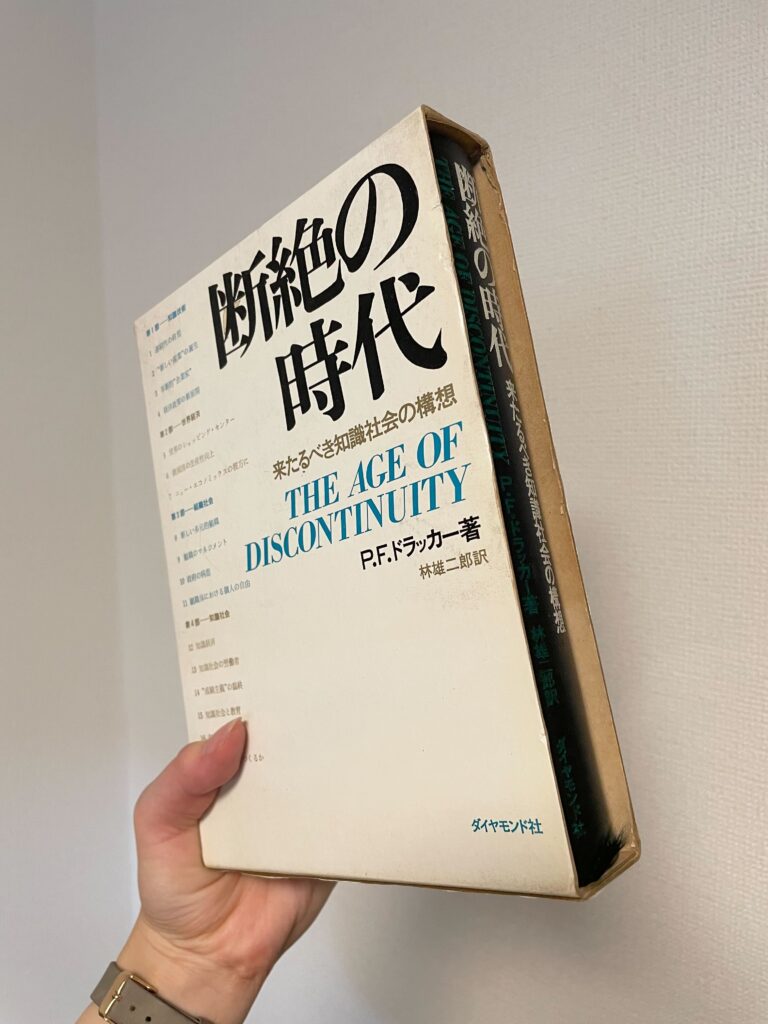Who is P.F. Drucker?

Have you ever heard of the book “Moshi Dora(もしドラ)”? The book is about a high school girl, Minami Kawashima, who is the manager of a small baseball team at a public high school, who picks up a book called “Management” by chance, which is written by Peter F. Drucker. In the early 2010s, this novel became a million-seller and triggered a Peter Drucker boom.
If you have visited our website, you have probably heard of Peter Drucker. Some people in the business administration industry, or even those who are involved in management in a broader sense, may have his books as their favorite. In this blog, I would like to shed light on Peter Drucker, who is described as the father of modern managemenet.
(Photo: Peter Ferdinand Drucker)

(Reference: Official Drucker Japan website)
Peter Ferdinand Drucker (1909-2005) was of Jewish descent on both sides of his family. (However, his parents converted to Christianity and lived in what he referred to as a “liberal” Lutheran Protestant household in Austria-Hungary.) After graduating from the prestigious Goethe-Universität Frankfurt (often simply called the University of Frankfurt) in Germany, he was a member of the “Frankfurter General-Anzeiger” in Frankfurt am Main, Germany, in 1929. In 1931, he received his doctorate in law from the University of Frankfurt. Around this time, he was offered a job at the Ministry of Information in recognition of his talent for writing, and in relation to this, he was allowed to interview Adolf Hitler and Joseph Goebbels, who were head of the National Socialist German Workers’ Party (Nazi). However, Drucker, who had observed the rise of Nazi Germany with hatred, describing “that ominous 1933 when Hitler and Roosevelt both came to power [P.F.Drucker69, p.9],” wrote the philosophical essay knowing that he would incur their displeasure. Being Jewish himself, he moved to London. He worked as an analyst at the Merchant Bank, a financial institution that had its origins in London in the early 19th century during the development of the British Industrial Revolution, before moving to the United States in 1937. After serving as a professor at New York University, he was appointed the Marie Rankin Clark Memorial Professor of Social Sciences and Business Administration at Claremont Colleges in 1971, where he continued his writing, teaching, and consulting activities.
Drucker’s father, Adolf Drucker (1876-1967) was a prominent Viennese lawyer and civil servant, (later retired as president of a bank and professor at the University of Vienna, the University of North Carolina, the University of California, etc.), and was also a trained future economist.
According to the official Drucker Japan website, Drucker’s areas of expertise include politics, governance, economics, management, history, philosophy, psychology, literature, art, education, and self-realization, and he has had a profound influence on a wide range of fields. (In the last August, one of the books posted by Takeo Harada, Founder and CEO of our Institute on our official Instagram. “The Perfect Human Being (1998)” by Abraham Harold Maslow (1908-1970), an American psychologist. Drucker was also greatly influenced by Maslow’s Hierarchy of Needs.) His books include “The Age of Discontinuity (1969),” “Management (1974),” “The Future That Has Already Happened (1994),” and “The Essential Drucker (2001),” etc. In addition to those published books, there are nearly 70 books on Drucker, including collections of his articles, critical biographies, and an introduction by his alter ego in Japan, Atsuo Ueda. In this blog, I will focus on “The Age of Discontinuity,” which explains the fundamentals of management science.
(Photo: The book “The Age if Discontinuity”)

(Photograph taken by the author)
In Part III, Organizational Society, 9: Management of Organizations, Drucker makes it clear that “Unless we first know what organizations exist for, we will not know much about them. [P.F.Drucker69, p.247]”According to Drucker, there are three main functional and operational areas of an organization: (1) Purpose (goals), (2) management, and (3) individual actions.
(1) Purpose (goals)
If the purpose of an organization is not clearly defined, it’s impossible to determine the effectiveness of its activities and whether or not it is achieving results. However, there is no scientific way to set goals for an organization, and this is truly a matter of value judgment and a truly political issue, he says.
“Decisions are made under uncertainty with no hope of resolution. Decisions are about the future, and we have no “facts” about the future. Therefore, there is always a clash of plans and a struggle between political values in this realm. [P.F.Drucker 69, p.250 ]”
In this context, the two most important “decisions” to be made within the organization are, first, what to stop and, second, what to give priority to. (As a new full-time employee since April of this year, I am not quite in the managerial mindset, but I know the importance of proper prioritization for a given task.) Drucker said, “The decision of what to stop is of the utmost importance, and failure to do so will lead to the worst possible outcome. [P.F.Drucker69, p.251]” The essential thing in an organization is to separate the ‘decision makers’ from the ‘doers’. For example in the human body, the brain’s commands (the decision makers) are followed by the hands and feet (the doers).
(2) Management
He states that “All organizations bring together a large number of people to perform a coherent task [P.F.Drucker69, p.256],” and thus they face the challenge of maintaining a balance between the various purposes of the organization while countering the needs and desires of each individual. He also states that “Knowledge workers make modern organization possible. Conversely, the crisis of the organizational body has created jobs and opportunities for knowledge workers. How to make knowledge productive, however, remains to be seen. It is either by chance or by intuition that it is done.[P.F.Drucker69, p.260]” The words ‘by chance’ or ’by intuition’ can be linked to “awareness, intuition, and abduction toward the future,” as described by Takeo Harada, Founder/CEO of the Institute.
Furthermore, regarding the balance between efficiency (represented by government officials and accountants) and usefulness (emphasizing results) in management,
“The efficiency approach sees that management is necessary and that it is the power of the organization. The effectiveness approach sees management as supportive and only a minimally necessary evil to prevent ruin. [P.F.Drucker 69, p.259]” Also he describes, “The efficiency approach tries to create something so mediocre that it can repeatedly produce predictable results. -In the effectiveness approach, you try to free up creative energy.[P.F.Drucker69, p.259]” Both approaches are based on a pragmatic view. However, Drucker himself states that he supports the one of usefulness, which seems to indicate the significance of being concerned with results and outcomes.
(iii) Individual behavior
This one questions the effectiveness of the people who make up the organization. Drucker states, “The prosperity of our society as a whole is increasingly dependent on the ability of large numbers of knowledge workers to effectively run a true organization. It also increasingly depends on the performance and satisfaction of knowledge workers. [P.F. Drucker69, p.261]” He goes on to say that organizations need individuals to be able to make the decisions that are rightly theirs. Furthermore, “The competence, training, and knowledge of the executive have been emphasized, but his attributes, especially his effectiveness, have been neglected … Few executives have even a tenth of the effectiveness that their competence, knowledge, and the industry to which they belong deserve. [P.F.Drucker69, p.262]”
These three areas are quite different, yet belong to the same field and the same dimension of the organizational body, and all relate to the functioning of the organizational body. Don’t you think it possible to interpret that “business administration” for Drucker was not just a theory of making money, but a sacred study to elucidate the corporate organization?
Drucker explained his book as follows at the beginning:
“This book is not about predicting trends, but about discontinuities. It does not predict tomorrow, but looks directly at the present. It does not ask, ‘What will tomorrow look like? [P.F.Drucker 69, p.11].”
These words give us a glimpse of the philosopher-like side of Drucker.
Drucker says of social transformation in this way:
“The most important change concerns ‘knowledge’. Knowledge has become the most central capital or cost item or economic resource in the past decade. It has changed labor and work, teaching and learning, and the nature and use of knowledge. Moreover, this change has raised anew the question of the responsibilities of the new powers, the intellectuals. [P.F.Drucker69, p.8]
He narrates the transition from physical labor to knowledge labor admirably, and the importance of knowledge labor that we still face in the modern world of 2024. In the next blog, I would like to further explore the “knowledge society” he describes from the perspective of ‘education’.
Chancellery Unit, Group for Project Pax Japonica, Maria Tanaka
※The statements in this blog are not the official views of the Institute, but rather the personal views of the author.
[References]
・[P.F.Drucker69]P.F.Drucker, Translated by Yujiro Hayashi,“The Age of Discontinuity”, Diamond, Inc., 1969.



